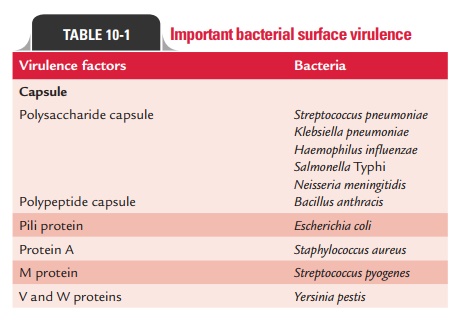Chapter: Microbiology and Immunology: Microbial Pathogenesis
Infection and Types of Infections
Infection
This is a process when an organism enters the body, increases in
number, and causes damage to the host. All infections do not invariably result
in the disease.
The term infection has
more than one meaning: (a) the
pres-ence of microbes in the body and (b)
the symptoms of the dis-ease. The presence of microbes in the body does not
always result in symptoms of the disease. Bacteria cause symptoms of disease by
two main mechanisms: (a) production
of toxins, both endotoxin and exotoxin and (b)
production of inflammation.
The words “virulence” and “virulent” are derived from the Latin
word virulentus, meaning “full of
poison.” The term viru-lentus is
derived from the Latin words virus (poison)
and lentus (fullness), and, in turn,
the term virus may be related to the
Sanskrit word visham, meaning
“poison.”
Virulence is a measure of a microbe’s ability to cause disease.It is a
quantitative measure of pathogenicity and is measured by the number of
organisms required to cause disease. It means that a highly virulent microbe
requires fewer organisms to cause disease than a less virulent one; hence it is
directly depen-dent on the infectious dose of the organism.
The 50% lethal dose (LD50) is the number of organisms
required to kill half of the hosts, whereas 50% infectious dose (ID50)
is the number of microbes needed to cause infec-tion in half of the hosts. The
infectious dose of an organism required to cause disease varies among the
pathogenic bacteria.

For example, the infectious dose of Shigella to cause dysentery is less than 100 organisms, whereas
that of Salmonella to cause diarrhea
is more than 100,000 organisms.
The virulence of a microbe is determined by virulence fac-tors,
such as capsules, exotoxins, or endotoxins (Table 10-1).
Pathogenicity is the capacity of a pathogen species to
causedisease, while virulence is used to describe the sum of disease causing
properties of a population (strain)
within the species. Pathogens can be distinguished from their avirulent
counter-parts by the presence of specific genes or gene clusters in the genome
known as pathogenicity islands.
The diseases that can be spread from one person to another are
called communicable diseases. Most microbial infections are communicable
diseases.
Three epidemiological terms are often used to describe infection:
endemic, epidemic, and pandemic:
·
Endemic: The infection that occurs at
a persistent, usuallylow level in a certain geographical area is called
endemic.
·
Epidemic: The infection that occurs at
a much higher ratethan usual is known as epidemic.
·
Pandemic: Infection that spreads
rapidly over large areas ofthe world is known as a pandemic.
Types of Infections
Infections may be of the following types:
·
Primary infection: This condition denotes an
initial infec-tion with an organism in a host.
·
Reinfection: This condition denotes
subsequent infectionwith the same organism in the same host.
·
Secondary infection: This condition denotes an
infectionwith a new organism in a host whose body resistance is already lowered
by a pre-existing infectious disease.
·
Cross-infection: This condition denotes an
infection with anew organism from another host or another external source in a
patient who is already suffering from a disease.
·
Nosocomial infection: Cross-infections acquired in
hos-pitals are called hospital-acquired, hospital-associated, or nosocomial
infections.
·
Iatrogenic infection: This condition denotes a
physician-induced infection as a result of therapy with drugs or inves-tigation
procedures.
·
Subclinical infection: Inapparent clinical
infections arecalled subclinical infections.
·
Latent infections: This denotes a condition in
which someorganisms may remain in a latent or hidden stage in host and
subsequently they multiply to produce clinical disease when host resistance is
lowered.
Related Topics